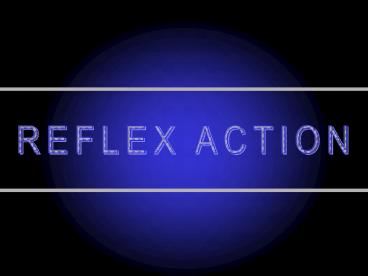REFLEX ACTION - PowerPoint PPT Presentation
1 / 13
Title:
REFLEX ACTION
Description:
ACTION COGNITIVE REFLEX Definition: Involuntary motor response to a sensory stimulus without conscious awareness. The neural pathway for a reflex action is called ... – PowerPoint PPT presentation
Number of Views:1291
Avg rating:3.0/5.0
Title: REFLEX ACTION
1
REFLEX ACTION
2
ACTION
COGNITIVE
REFLEX
Definition
Involuntary motor response to a sensory stimulus
without conscious awareness. The neural pathway
for a reflex action is called Reflex Arc.
3
Basic Organization of a Reflex Arc
4
A.P.
E.P.S.P.
R.P.
E.P.S.P.
E.P.P.
A.P.
A.P.
Receptor
Afferent Limb
Afferent Neuron
Reflex Arc
Center
Efferent Neuron
Efferent Limb
Effector organ
5
Terms Associated with Reflex Arcs
- Monosynaptic // Polysynaptic Reflex
- Reciprocal innervation
- Ipsilateral Reflex // Contralateral Reflex
- Segmental Reflex // Intersegmental Reflex
6
Reflex Arc
Monosynaptic
Polysynaptic
e.g. Stretch Reflex
e.g. Withdrawal Reflex
7
Reciprocal Innervation
Reciprocal Inhibition
8
Ipsilateral and Contralateral Reflex
Crossed Extensor Reflex
9
Intersegmental Reflex
10
Properties Reflex Action
- Irradiation of Stimulus
- The spread of excitatory impulses up and down
the spinal cord to more and more motor neurons.
2. After-discharge A strong stimulus causes
prolonged flexion due to prolonged repeated
firing of the motor neurons by impulses
arriving from the reverberating circuits.
- Local Sign
- The exact response pattern depends upon the part
of the limb stimulated. When medial surface of
the limb is stimulated, the response will include
some abduction. This is for effectively removing
the limb from the noxious stimulus.
11
- Fractionation
- Supramaximal stimulation of any of the sensory
nerves from a limb never produces as strong a
contraction of the flexor muscles as that
elicited by direct stimulation of the muscles
themselves. Each input goes to only part of the
motor neuron pool for the flexors of that limb
there is fractionation of the motor neuron pool.
5. Occlusion If all the sensory inputs are
dissected out and stimulated one after the other,
the sum of the response developed is greater than
that produced by stimulation of all inputs at
once. This is because various afferent inputs
share some of the motor neurons.
12
6. Adequate Stimulus Reflex actions are
stereotyped and specific in terms of stimulus and
response. The particular stimulus that triggers a
reflex is called the adequate stimulus for that
reflex. E.g. the scratch reflex in dog in
response to multiple linear touch stimuli
produced by an insect crawling across the skin.
7. Final Common Path All neuronal influences
affecting muscular contraction ultimately funnel
to the muscle through the motor neurons. On a
typical spinal motor neuron there are several
excitatory and inhibitory inputs from the same
spinal segment, from other levels of spinal cord
and from multiple long descending tracts from the
brain. All the pathways converge on and determine
the activity in the final common path.
13
8. Central Excitatory and Inhibitory
States Prolonged states of excitatory or
inhibitory influences observed in spinal cord,
possibly because of activity in reverberating
circuits or prolonged effects of synaptic
mediators. When the central excitatory state is
marked, the excitatory impulses irradiate not
only to many somatic areas but also to autonomic
areas causing responses like urination, sweating
and blood pressure changes also along with
prolonged withdrawal-extension patterns.































